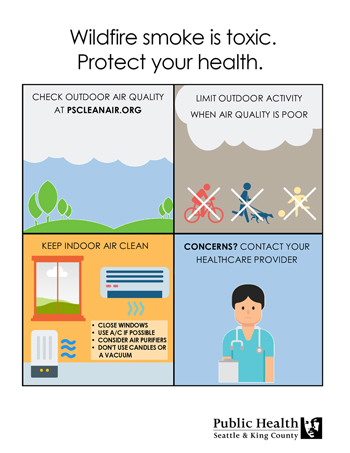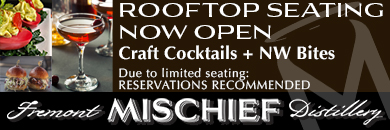
The Seattle Office of Emergency Management has issued advice for protecting ourselves and our pets if the air quality gets bad from wildfire smoke. There are steps you can take, if wildfire smoke does arrive in Seattle, to limit its entrance in your home and workplace.
Before the smoke arrives, take steps:
- Keep indoor air as clean as possible – avoid smoking/vaping inside, ventilate cooking smoke, and don’t burn candles/incense for entertainment
- Purchase an air purifier or air cleaning device (they will be in higher demand if smoke arrives so if you need one, purchase it soon) An air cleaner with a high-efficiency particulate air (HEPA) filter will reduce the number of irritating fine particles in indoor air. A HEPA filter with charcoal will remove some gases from the smoke. Do not use an air cleaner that produces ozone.
- Monitor local forecasts/air quality news through sources like gov, and sign-up to receive emergency alerts through Alert.Seattle.gov
Another option is creating your own ‘clean air fan’ for your home, or workplace. The Public Health Crafter’s Corner shared instructions for creating a DIY, low-cost fan. What you need is:
- a 20” x 20” electric box fan
- a 20” x 20” MERV 13 or FPR 10 air filter (the acronyms are for filter ratings)
- one 48” bungee cord (or multiple bungee cords that create a 48” upstretched bungee – or duct tape)

To assemble the clean air fan find the arrows on the outside edge of the filter box, and find the backside of the box fan. Press the filter against the backside of the fan – with the arrows pointing towards the fan. Wrap the bungee cord around the fan and the filter, and hook the two ends together so that the filter is secured to the fan. You can also use duct tape instead of a bungee cord.
Visit the Public Health Crafter’s Corner blog (click here) for more tips on how to use your filter fan. If you need more visual instruction, check out videos from Seattle & King County Public Health (click here,) and the Washington Department of Ecology (click here.)
When the smoke arrives, protect your health and that of pets by:
- Avoid physical exertion outdoors if smoke is in the air
- Keep indoor air as clean as possible – keep doors and windows closed
- If running air conditioning, set it to re-circulate and close the fresh-air intake and change the filter regularly
- If needed, masks – like the N95, N100, or KN95 – can offer limited protection from the smoke – find out more from this Department of Health flyer (click here)
- Consider leaving the area if air quality is poor and you cannot keep your indoor air clean, especially if you or those you care for have at-risk health problems
The City may take steps during poor air quality times to protect those sensitive to smoke, including opening smoke shelters. The City has also issued specific tips for protecting pets (and livestock) at . Learn more about safe steps in the case of wildfire smoke, visit the Seattle.gov website (click here.)

